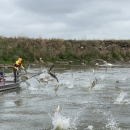Species that are considered high risk have a well-documented history of invasiveness in at least one location globally, and a high or medium climate match to the contiguous United States.
Lagarosiphon major, African Elodea, is an aquatic plant that is native to southern Africa and has been introduced to and become established in Europe, Japan, and New Zealand. It has also been introduced in eastern Australia. This aquatic species prefers lakes, reservoirs, and slow-moving rivers with silty and sandy substrates. L. major is a dioecious species, however only female plants have been found outside of its native range. L. major has been used as an ornamental plant in the aquarium industry which has led to introduction of this species through trade. Despite no occurrences of this species in the wild found in the United States, L. major is federally listed as a noxious weed and is regulated by several States. Introduced populations of L. major have negatively impacted native aquatic flora and fauna, and water quality; and impacts to local economies and infrastructure have also been reported. The history of invasiveness for L. major is High. The climate matching analysis for the contiguous United States indicates establishment concern for this species. Areas of high match occurred in the Northeast, Great Lakes region, Ohio River basin, Rio Grande basin, Appalachia, and in parts of California. The Certainty of Assessment for this ERSS is classified as High due to the amount of information regarding this species’ biology, invasion history, and negative impacts of introduction. The Overall Risk Assessment Category for L. major in the contiguous United States is High.



